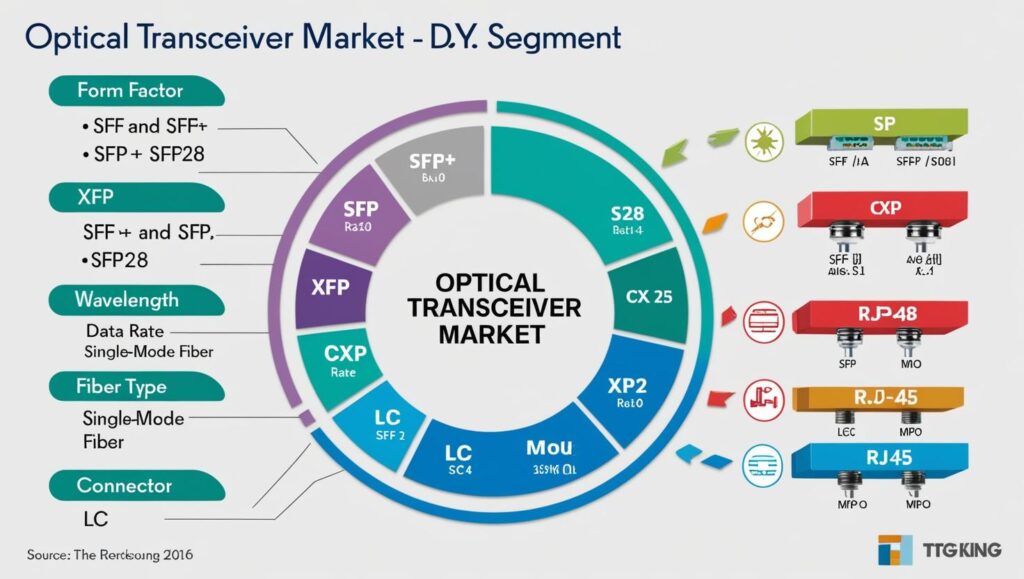As digital transformation accelerates across every industry, the demands placed on data networks are growing exponentially. The rise of technologies like 5G, cloud computing, artificial intelligence, and the Internet of Things (IoT) requires unprecedented bandwidth, ultra-low latency, and real-time responsiveness. Amid this shift, the Global Optical Transceiver industry is undergoing a major evolution, transitioning from traditional hardware to AI-enhanced components that are capable of enabling smarter, more agile network infrastructure. At the forefront of this transformation are AI-integrated optical transceivers, poised to redefine the future of high-speed connectivity.

The Evolution from Passive Components to Intelligent Systems
Historically, optical transceivers functioned as passive signal converters within network systems. They handled the critical task of converting electrical signals into optical signals and vice versa but lacked the intelligence to interpret or influence data flow beyond their defined operations. With the integration of artificial intelligence, these devices are no longer static. AI-enabled optical transceivers now monitor network health, identify anomalies, and adjust parameters dynamically—all in real time. This intelligence transforms them from basic communication interfaces into active participants in network optimization, offering new layers of adaptability and performance across the Global Optical Transceiver industry.
The Role of Artificial Intelligence in Performance Optimization
Artificial intelligence is playing a transformative role in enhancing the functionality and reliability of optical transceivers. AI algorithms can process vast amounts of real-time data to detect patterns, anticipate failures, and optimize signal quality. In environments where latency and reliability are mission-critical—such as autonomous vehicle networks, financial data centers, or emergency communications systems—AI-enabled transceivers can adjust power levels, temperature thresholds, and signal routing in milliseconds to maintain optimal performance. This real-time intelligence ensures that networks are not only faster but also more resilient, minimizing disruptions and enabling predictive maintenance strategies that lower operational costs.
Download PDF Brochure @ https://www.marketsandmarkets.com/pdfdownloadNew.asp?id=161339599
Advanced Diagnostics and Predictive Maintenance
One of the most valuable applications of AI in optical transceivers is in diagnostics and maintenance. Traditional network issues are often diagnosed after a failure has occurred, resulting in costly downtime and delayed repairs. In contrast, AI-integrated transceivers continuously monitor internal and external conditions, such as laser degradation, connector integrity, and thermal fluctuations. When potential issues are detected, the system can trigger alerts or even initiate automated corrective actions. This capability is significantly improving uptime and reducing the need for manual inspections across telecommunications and data center environments, strengthening the position of AI in the Global Optical Transceiver industry as a core driver of operational efficiency.
Impact on High-Speed Network Deployments
As the world moves toward 400G, 800G, and even terabit-scale networks, the demand for intelligent optical components has never been higher. AI-integrated optical transceivers support these high-capacity systems by delivering enhanced modulation techniques, advanced signal correction algorithms, and optimized energy use. These features are crucial for hyperscale data centers and cloud infrastructure providers that operate in highly dynamic traffic environments. Moreover, AI allows these transceivers to work harmoniously within complex network topologies, adapting to varying data loads, latency requirements, and fault conditions with minimal human intervention. This adaptability is critical as the Global Optical Transceiver industry pushes the boundaries of speed and scale.
3D Sensing, Coherent Technology, and Edge Computing Synergy
The future of optical transceivers also lies in their ability to integrate with emerging technologies like 3D sensing, coherent detection, and edge computing. With AI as a unifying intelligence layer, these transceivers can interpret multi-dimensional signal data, improve phase and amplitude detection, and support distributed intelligence at the network edge. This is particularly relevant in smart city deployments, autonomous logistics systems, and industrial automation environments, where latency and data prioritization are paramount. By enabling faster, more context-aware decision-making at the edge, AI-integrated transceivers are expanding the functional scope of the Global Optical Transceiver industry beyond traditional telecom and into next-generation applications.

Smart Networking for Smart Infrastructure
The integration of AI into optical transceivers is not only enhancing performance—it is laying the foundation for smart networking ecosystems. In these systems, every component, from core routers to end-point sensors, operates in a feedback loop driven by data. AI-integrated transceivers contribute critical data on bandwidth usage, signal quality, and environmental conditions, enabling centralized platforms to manage the network holistically. These smart networks are better equipped to handle variable workloads, support autonomous applications, and scale rapidly to meet changing demands. As urban infrastructure, transportation systems, and energy grids become more digitized, the Global Optical Transceiver industry will play a pivotal role in supporting intelligent, self-regulating communication networks.
Strategic Growth and Investment Opportunities
The shift toward intelligent optical networking is creating significant investment opportunities across the Global Optical Transceiver industry. Major telecom operators, cloud service providers, and governments are prioritizing infrastructure that can handle massive data volumes with intelligence and agility. As a result, manufacturers that focus on developing AI-ready transceivers are seeing strong demand from hyperscalers, 5G infrastructure projects, and cross-border data transport networks. In parallel, venture capital and private equity firms are increasingly investing in startups and scale-ups that offer integrated AI-Network solutions, software-defined optics, and next-gen photonics platforms.
Conclusion: Intelligence as the Cornerstone of the Future Network
AI-integrated optical transceivers are more than just an incremental improvement—they represent a fundamental evolution in how networks are built and managed. By embedding intelligence directly into the hardware layer, these transceivers enable a new level of automation, insight, and adaptability that will define the networks of the future. The Global Optical Transceiver industry is well-positioned to lead this transformation, offering not just faster connections but smarter, self-optimizing systems that align with the growing demands of a digital-first world.
As we move toward fully autonomous, software-defined networks, the marriage of optical hardware and artificial intelligence will become the new industry standard. Stakeholders across telecom, data infrastructure, and enterprise IT must now look beyond speed and bandwidth—toward intelligence, resilience, and the transformative power of AI-enabled connectivity.
About MarketsandMarkets™
MarketsandMarkets™ is a blue ocean alternative in growth consulting and program management, leveraging a man-machine offering to drive supernormal growth for progressive organizations in the B2B space. We have the widest lens on emerging technologies, making us proficient in co-creating supernormal growth for clients.
The B2B economy is witnessing the emergence of $25 trillion of new revenue streams that are substituting existing revenue streams in this decade alone. We work with clients on growth programs, helping them monetize this $25 trillion opportunity through our service lines – TAM Expansion, Go-to-Market (GTM) Strategy to Execution, Market Share Gain, Account Enablement, and Thought Leadership Marketing.
Built on the ’GIVE Growth’ principle, we work with several Forbes Global 2000 B2B companies – helping them stay relevant in a disruptive ecosystem. Our insights and strategies are molded by our industry experts, cutting-edge AI-powered Market Intelligence Cloud, and years of research. The KnowledgeStore™ (our Market Intelligence Cloud) integrates our research, facilitates an analysis of interconnections through a set of applications, helping clients look at the entire ecosystem and understand the revenue shifts happening in their industry.
To find out more, visit www.MarketsandMarkets™.com or follow us on Twitter, LinkedIn and Facebook.
Contact:
Mr. Rohan Salgarkar
MarketsandMarkets™ INC.
1615 South Congress Ave.
Suite 103
Delray Beach, FL 33445
USA : 1-888-600-6441